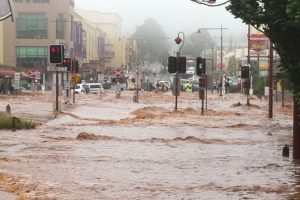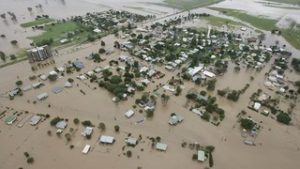 Learning intentions
Learning intentions
- KNOW: How a natural hazard can impact people and property.
- UNDERSTAND: What makes communities vulnerable to the impacts of a natural hazard.
- DO: Explain how a natural hazard can become a disaster.
Success criteria
I can: Describe what the difference is between a natural hazard and a disaster.
A disaster occurs when a community is unable to protect itself from the impact of a hazard event and there is widespread damage to property, loss of life or injuries.
Natural hazards are predominantly associated with natural processes and phenomena. Natural hazards such as storms, floods and bushfires don’t inevitably lead to a disaster.
A disaster only occurs when a natural hazard impacts upon a vulnerable community.
This can be represented in a disaster equation:
Natural Hazard + Vulnerable Community = Disaster
Vocabulary and concept cards: Use this list to develop your understanding of key concepts and vocabulary in this lesson.
If you prefer to answer the quiz questions in your hand writing then you can print and use one of these worksheets:
1
Sharing homework results- record a local story
Do you have a disaster story that you recorded for homework? You may want to share the story with the class.
- Who did you interview?
- What disaster event did they tell you about?
- What were the impacts of the hazard on the person you interviewed? How did it affect them?
2
How a natural hazard becomes a disaster
View this video and complete the quiz.
3
Learning from history
Depending on the hazard most likely to impact your area, select either a flood or bushfire disaster.
Grantham and Lockyer Valley Floods 2011
On the 9th and 10th of January 2011, heavy rainfall caused flash flooding to occur across parts of Queensland resulting in 35 fatalities and widespread damage to property. Grantham, Lockyer Valley and Toowoomba were severely impacted. Due to landslides caused by flooding, and water blocking the Warrego highway, the Lockyer Valley became isolated; police and emergency services were no longer able to access the area. Excessive fog and rain prevented helicopters flying overhead during the emergency.
Residents of these areas received no warning, unlike the larger towns of Brisbane and Ipswich. The Tsunami like force of the flood was unlike anything that could have been anticipated.

The town of Grantham after the 2011 flood.
Of the 35 people who died as a result of the 2011 Queensland floods, 21 deaths occurred in the Toowoomba and Lockyer Valley area.
The community felt a false sense of security after the construction of the Wivenhoe dam in 1974; therefore many homes and businesses had been built on floodplains. The dam was designed to lessen the risk of such disasters but could never have completely eliminated the risk. Due to unprecedented rainfall over this period, the dam was unable to hold the massive volume of water.
I was complacent and thought we were safe. I thought there would never be a bigger flood … The attitude that “it will never happen” is no longer an option. – Mr Keep
Residents of Grantham and Lockyer Valley received no flood warnings, news of the disaster only spread by word of mouth if it was received at all. Other people were only alerted to the danger when it became visible.
Many people in the community found it difficult to believe their neighbors who were spreading the word of the floods imminent threat.
I was told to get out of Grantham because there was a big wall of water coming and that Grantham was going to go under, I found it difficult to believe that water in the Lockyer Valley could reach that height. – Mr Warburton
People’s homes were rapidly inundated with water which quickly rose to rooftops, washing away cars, equipment as well as sheds and some houses. Most residents had no time or opportunity to evacuate once they became aware of the dangers. They were also unaware how quickly and dramatically the flood waters would rise, eventually reaching rooftops.
Some people attempted to travel through flood waters in vehicles.
The Perry family became stranded in their car as flood waters rose. They managed to climb out of the windows and onto the roof of the car at the last minute. Channel 7 helicopters spotted the family but by the time they returned to rescue them the car had disappeared. The family members were found nearby clinging to tree branches and their 9 year old son on top of a floating cattle feeder. Unfortunately one family member was swept away.
The community is now more aware of the flood risk to their area and the factors that make them vulnerable.
Don’t be complacent about the risk of natural disasters which strike suddenly. Don’t expect warning. Don’t rely on anyone to save you. Be prepared to protect your own family. – Mr Keep
Years later, many of the homes were rebuilt on higher ground nearby to avoid future floods impacts.
2009 Black Saturday bushfires
The fire danger weather in Victoria on Black Saturday was the worst on record. By mid-afternoon, hot north- westerly winds were blowing at 125km/h and temperatures in Melbourne had peaked at 46.4°C. On the back of a 12 year drought, the vegetation was tinder dry and once fires had started there was very little the fire services could to do to contain them.
By Sunday morning, 143 people had died and over 2000 houses had been destroyed. This was the worst bushfire disaster Australia had ever seen.
While the Black Saturday bushfires were the most extreme on record, it is important to understand the role that ‘human factors’ played in the disaster. By listening to the stories of survivors, we can learn a lot about what made people vulnerable to the impacts of the fires.
In the lead up to Black Saturday, people were warned that the fire danger was extremely high. On the Friday evening, the Premier John Brumby had given Victorians a stark warning. Appearing on the nightly news bulletin, he said:
“Tomorrow is going to be worst day in the history of the State… I can’t stress this enough, I know that the Chief Fire Officer has been out and he said it will be as bad as you can get and he’s not exaggerating.”
However, many people didn’t see this message as applying to them. They just didn’t think they could ever be affected by bushfire.
“I didn’t really think about it…I mean, I thought about it, not for ourselves, but to the point of other people, ‘cause I know people that live in fire danger areas but certainly didn’t think a fire would come through here”. – Narre Warren South
Many people hadn’t done anything to prepare their property for bushfire. For some people, it hadn’t been a major priority. They may have mowed the lawn, but they did this to keep the property neat and tidy, not to reduce the fire risk.
“I hadn’t taken any measures or anything. I mean, all I did was basically keep the grass cut all the time…Not because of bushfire reasons, only because I wanted it neat”. – Flowerdale
Black Saturday was Victoria’s hottest day on record. This meant that many people were trying to keep cool in the air-conditioned comfort of their homes. To keep the house cool, some people had also drawn the curtains, so they weren’t able see or hear any signs of an approaching fire. They were completely unaware of what was happening around them.
“We just decided to have one of those really ridiculous days where you lay back and watch a DVD. And so we’d pulled all the blinds and then the house stays nice, you know, has a better chance of keeping a reasonable temperature. So we had pulled all the blinds and we had the air-conditioner on in there and we had this DVD blaring really loudly”. – Mike, Hazelwood
For people who were monitoring the fire threat on the TV or radio, a lack of up-to-date information prevented access to advanced warnings.
“I went to the CFA website and I also went to the DSE website, but the DSE website was so slow. They were probably about three hours behind in their information”. – Kinglake
For some people, leaving just wasn’t possible. By the time they’d become aware of the fire, it was too late to try and escape. Some of these people made the dangerous decision to shelter in bathrooms and this caused of a high number of fatalities. Perhaps they thought the bathroom would be safe because there is water in there, but the bathroom is probably the most dangerous place you could go.
“Lots of people I know died. Why? Because they were all in the bathroom and the bathroom hasn’t got an external door, and the bathroom hasn’t got a big enough window to get out of”. – Marysville
Many people decided to stay and defend their properties and many were successful. But others weren’t as prepared as they needed to be. Some people were relying on simple plastic garden hoses that melted in the heat.
“Once the fire front went through, the wind was still blowing. We realised that our pumps and hoses and everything had melted and we just used metal buckets with a mop”. – Hazelwood South
Black Saturday reminded a whole new generation of the dangers of bushfires.
Watch the following youtube video “Lessons from the Past” for more information on the bushfires and Black Saturday.
4
Optional activities
Emergency Management Plan – you can access your school’s emergency management plan or the local government’s municipal emergency management plan. These plans will list the most common natural hazards in your area and the strategies to mitigate and manage them. Now think-pair-share:
- Can you think of people in your community who might be vulnerable to the impacts of a local hazard?
- Would you or your family be vulnerable to the impacts of a disaster? If so why? If not, why not?
5
Exit pass
One way a natural hazard can impact a person or community is…?

